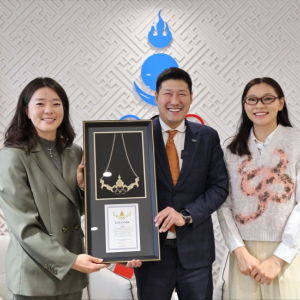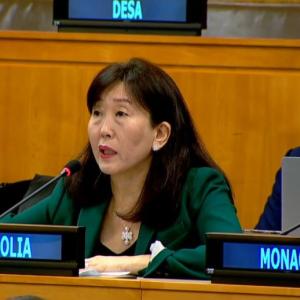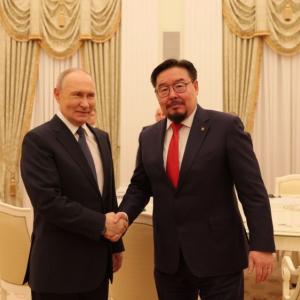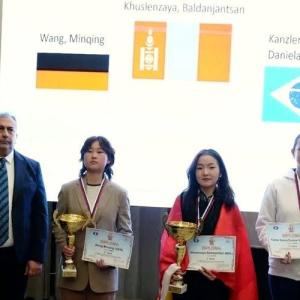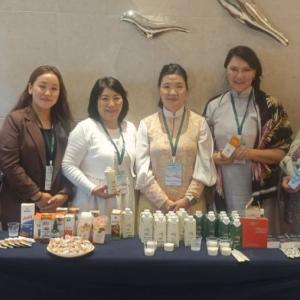Shannon Cowlin: ADB-Supported Projects in Mongolia Target Mitigating Climate Change Impacts
The Mongol Messenger
Ulaanbaatar, November 8, 2023 /MONTSAME. We spoke with ADB Country Director for Mongolia Shannon Cowlin during our visit to ADB-funded project sites in Mongolia to learn about the progress and results of those projects and programs.

-Your first field visit as a Country Director was conducted in Khuvsgul aimag. You and your team met with the officials and local authorities and witnessed the implementation of projects at the site. What is your assessment of those projects? What would be the areas to focus on going forward?
-Thank you very much. It was a great pleasure to visit ADB-funded projects in Khuvsgul. It was my first time seeing any of those projects.
I witnessed project results such as infrastructure, roads, and wastewater treatment plants. But it was most gratifying for me to find that people and the environment were at the center of every single project. For example, the Sustainable Tourism Development Project is enabling increased tourism whilst ensuring the local communities benefit and environmental protection in this pristine part of Mongolia.
I was also encouraged to see the strong support of the local government, both at the aimag and soum levels. Continuous appreciation from the community members who were beneficiaries of the project sends a message that our projects are doing well.
In terms of going forward, these projects are not completed yet. So, we will support the government in any challenges that they might face, whether it’s related to a short construction season or contract management, to make sure that the projects are successfully completed.

-You have worked at the Asian Development Bank before your appointment as a Country Director. What types of projects did you work on most frequently in the past?
-Before becoming a Country Director for Mongolia, I worked as an energy specialist for ADB for more than 10 years. I've worked in the country office in India and at our headquarters where I worked on projects in Southeast Asia covering the Philippines, Indonesia, and Vietnam. I've been in Mongolia for almost two years now.
All this time, I focused on clean energy including solar, wind, geothermal, electric vehicles, and the whole range of clean energy technologies to help countries with their energy transition.
-As an expert in the energy industry, how do you assess the situation and process of energy transition and reform in Mongolia?
-Mongolia has made some strong initial moves towards energy transition with renewable energy projects that were developed by the private sector, and also our Upscaling Renewable Energy Project for which we saw one of the solar plants in Murun.
But Mongolia remains one of ADB's most coal-dependent member countries, with more than 90 percent of electricity generated domestically coming from coal-fired power plants.
Globally, there have been drastic reductions in the cost of renewable energy technologies. Mongolia’s wind and solar energy potential is quite vast which is sufficient to supply power to meet the needs of all Northeast Asia. So, there's significant untapped potential for future renewable development, both for domestic consumption and possible export to the neighbors, such as China, or even green hydrogen production.
ADB has supported several countries in the region to conduct renewable capacity procurement through an auction mechanism. Through competitive procurement and transparency, the cost can substantially decline. We think that if Mongolia were to adopt such an approach, new additions of renewables, such as solar and wind, would be cheaper than any new additions of coal. However, adding more wind and solar energy sources requires a different approach to managing the grid. It also requires flexibility in the system. ADB is supporting a battery energy storage project that will add some flexibility to the system.
We also helped the Ministry of Energy with the conceptual design for a pumped storage hydro power plant that would allow for significantly increased additions of solar and wind energy in the future.

-The Asian Development Bank is implementing many projects in Mongolia across a wide range of social and economic sectors. Do you collaborate with the Mongolian Government to identify the needs and demands of society and the country?
-ADB works in close partnership with the Government. Every four years, we establish a Country Partnership Strategy, where ADB outlines its approach to support the Government over four years in line with the Government's medium and short-term development strategies. Our current Country Partnership Strategy for 2021 to 2024 is closely aligned with Mongolia’s Vision 2050 and the New Recovery Policy.
Furthermore, we discuss a specific list of projects every year. For example, we discussed in early 2023 the projects that ADB would finance for 2024 and 2025. Oftentimes, the individual line ministries propose projects, and then ultimately, the Ministry of Finance and the Ministry of Economy and Development decide what the most strategic deployment of state debt will be in prioritizing the projects for ADB investment.

Once we have the list of projects, we do a range of assessments for each individual project. We look at the project approach and see if we can integrate international best practices or innovative designs into the project. And then, we also do assessments to ensure that it will bring economic benefit to the country and the people, and also look at environmental and social risk management aspects. So, usually, by the time an ADB project is approved, we will have spent a million dollars or more on technical support to enhance the project design and ensure the project is ready for implementation.
We also ensure that ADB-supported projects are enhancing any climate resilience elements that are appropriate for the project type. Lastly, we work to maximize gender benefits so that women have equal opportunities to participate in and benefit from the ADB projects.
-Please clarify what projects are selected for grants and what projects are for soft loans.
-This is an interesting question. Oftentimes, ADB uses grant resources to pilot a new approach. So, if this is a technology that's never been introduced in the Mongolian context before, or if it's a new approach to how we organize the project, we will use grant resources. In an ideal case, we learn something from a grant project that can find its way into other projects.
The use of a concessional loan or a regular loan depends on the nature of the project. Normally concessional loans are reserved for social projects. So, in areas where you might not see a financial return on the project, but where the economic value to the country is quite essential, we can use a concessional loan. That is exemplified by education and health sector projects that might not have financial returns, but the benefits to the country are substantial.
There should be a higher share of regular loans for projects that are in more commercial sectors, such as energy, where the loan should be able to be paid back through tariff.

-Now we understand that the planned projects and programs are reflected in the ADB Country Partnership Strategy for Mongolia. But, as an ADB Country Director of Mongolia, what policies and principles are you going to adhere to in the coming years?
-My first priority as a Country Director is to ensure the successful implementation of the existing Country Partnership Strategy, which runs through 2024. We will evaluate the implementation afterward.
Secondly, as a Country Director, I need to play a strong role in ensuring the smooth implementation of our projects. Unfortunately, some of our projects experienced delays and cost escalations because of the Russian invasion of Ukraine and the border closures. Making sure that all projects are on track is a big priority for the country office because the benefits to the country are realized only when the projects are completed.
Lastly, as we come to the end of the existing country partnership strategy, we'll be looking forward to the next strategy. And there are several areas that remain really critical for us to focus on.
-In terms of climate change, ADB will continue to support the country’s energy transition and improve climate resilience.
-Mongolia has experienced global warming above the average global temperature rise and this is having a straining effect on pastureland. Supporting agriculture while preserving pastureland through sustainable rangeland management will be a priority in the coming years.
-We will continue to support the government in increasing its resilience to economic shocks. Mongolia has been experiencing the boom-and-bust cycle because of its dependence on commodity exports. We will be looking at export diversification, and sustainable agricultural products, including value addition processing, import substitution, and fiscal stability.
-Across all of the above, we will ensure social inclusivity. So, whether that's making sure to provide new education or health facilities in the poor ger areas, or whether we're providing opportunity to people with disabilities or survivors of domestic violence, we want all Mongolians to be able to benefit from economic growth and opportunity.

 Ulaanbaatar
Ulaanbaatar










